In one of the opening sequences of Ashutosh Gowarikar’s Panipat (2019), a group of eighteenth-century Maratha sardars or chieftains assemble in the famed Shaniwarwada, the audience hall of the Peshwa or Maratha leader in Pune, to celebrate a recent victory. They break out in a song sequence with the words “we are victors of the battlefields, we are the sun that breaks through the dark nights, we are the ones who broke the age-old shackles of unfreedom…we the Maratha men.” Panipat is a paean to the Maratha warriors of western India, claiming to restore to them their rightful place in the battles for the making of the Indian nation. It is an addition to a long list of films made in India in the last decade that seek to reinterpret the events of history in a context defined by contemporary social and political milieu. However, the questions that face the 70-year-old Indian democracy are rather different today. Cinema in contemporary India has become the site and source for arguments over national identity. None is visible more than in the cinema halls where standing or not for the national anthem leads to daily fights over patriotism. Panipat raises questions of fidelity, loyalty, patriotism and belonging in its staging of a key military encounter between the Marathas and Afghans in eighteenth-century northwest India.
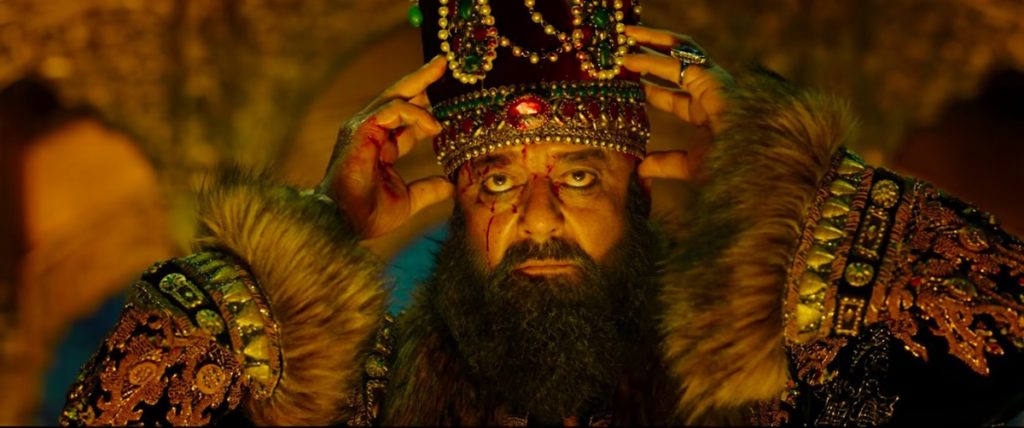
Panipat is the latest iteration of Bollywood’s renewed interest in medieval and early modern Indian history. If we explore the trajectory of “historicals” in Indian cinema, we find that such films have appeared at the most critical junctures of the social and political journey of the Indian nation, and reveal an interesting pattern about the place of historical narratives in Indian society. While the earliest Indian films explored mythologies, from the 1930s onwards—which was also the height of the freedom struggle in India—focus shifted towards exploration of the lives of historical figures. While aiming to entertain audiences, these films also focused on ideas that the new nation valued like independence, valor, peace, justice, honesty, pluralism, and harmony. By the 1970s, however, historicals had all but disappeared, save for a few war movies and biographies. In the last decade, though, we have seen a profusion of historicals in the popular media, with the production of films, television shows, books, computer games, and internet sites, indicating renewed public interest in history, and signifying yet another moment of churn in the journey of the nation.
The film is named after the Third Battle of Panipat (1761), the last to be fought between two major south Asian armies, the Marathas and the Afghans. The battle of Panipat has long occupied an important place in the Indian public imaginary, to the extent that the word Panipat has come to signify a battlefield, whether actual or notional. The filmmaker Gowarikar picks up this epic battle to engage with the question at the heart of public discourse in India today: Who stands to defend India against the ghuspethia (Hindi for invader/intruder/immigrant)? Ghuspethia is a rather potent word in contemporary India, used repeatedly by the Indian Home Minister Amit Shah to vilify Muslims in India, in the context of the ongoing protests against the controversial Citizenship Amendment Act and the National Registry of Citizens. Gowarikar’s retelling bases itself on historian T.S. Shejwalkar’s meticulous 1946 work on the battle, written from the perspective of the Maratha confederacy.[1] The film creates a binary that sets the Afghan military victory against the moral victory of Marathas, who are shown to take the responsibility of unifying and protecting “Hindustan” against the Muslim Afghan marauder.
The film charts the facts researched by Shejwalkar closely. It follows the military campaigns of Sadashiv Rao Bhau (1730-1761), a Brahmin warrior of the Peshwa’s clan, and that of Ahmad Shah Abdali (1722-1772), an Afghan warlord. Bhau and Abdali clashed in 1761 at a dusty battlefield close to the north Indian town of Panipat, a site previously known for two important battles in 1526 and 1556. The previous battles of Panipat, fought respectively by the Mughal emperors Babur and Akbar, had led to the establishment and ensured the continuity of the Mughal dynasty that ruled most of the Indian subcontinent from 1526 to 1857. However, by the middle of the eighteenth century, the Mughal empire had lost most of its famed military power and had shrunk to a very small part of northern India. On the contrary, the powers of the Mughal empire’s regional allies, like the Afghans, Rajputs, Marathas, Jats, Awadh, Hyderabad, and Bengal, had strengthened. In the ensuing political drama, each of these entities attempted to prop and control claimants to the Mughal throne in order to control Delhi, the symbolic seat of power in India.
In 1761, Abdali marched from Kandahar towards Punjab to counter growing Maratha influence in Punjab. On the other side, a numerically smaller Maratha army under Bhau marched towards northern India hoping to patch together multiple alliances with Hindu kings in that region. While initially Bhau managed to convince several chiefs to become a part of his campaign, several of them are shown in the film’s climactic moment to desert the Maratha cause out of self-interest or fear. Despite the odds, the Maratha forces fought a valiant campaign causing grave destruction to the forces of Abdali, who even in his own victory recognized the Maratha valor.
Panipat, like Jodha-Akbar (2008), Bajirao-Mastani (2015), Manikarnika (2019) andTanhaji (2019), is yet another example of a historical film that seeks to tell a story about the past while attempting to make a point about the present. As historicals have become popular, a number of groups have been trying to use cinema as a medium for invoking forgotten causes. Marathas from the western Indian state of Maharashtra are one such group. They rose as a formidable regional power in the latter half of the seventeenth century, challenging the Mughal empire under Shivaji (1627-1680). His descendants expanded the Maratha confederacy, defeating most of the rulers of northern India. Over the last few decades, Marathas have sought for themselves an aggressive Marathi nationalist identity, particularly under Shiv Sena (literally, the army of Shivaji), the dominant, Hindu nationalist, ruling coalition partner in Maharashtra.
In the world of popular Bollywood historicals, it is Rajputs of the western Indian state of Rajasthan who have conventionally occupied the center stage, representing moral warriors who opposed Islamic invaders. Though Marathas played a very important role in the eighteenth-century history of India, representations of the Maratha past in popular media have largely focused on Shivaji. He is often portrayed as the leader of Hindu resistance against the Mughal emperor Aurangzeb, typically shown as an orthodox Muslim ruler. Films like Bajirao-Mastani and Panipat shift the focus to post-Shivaji Maratha polity. In doing so, these films also claim for Marathas the space so far occupied by Rajputs as defenders of the proto-Indian nation, as in the song sequence Mard Maratha from Panipat mentioned earlier. All of these films profess an ideal of heroism accumulated from decades of popular representation in literary and visual culture: upholders of religion, genteel and moral warriors, protectors of female virtue, and above all defenders of a nation in the making. In the film Tanhaji, released soon after Panipat, Marathas are claimed to be the protectors of the janeu, the sacred thread worn by Brahmins, and the veil of virtuous women.[2]
These representations, however, flatten the much more complex history of eighteenth-century India and the role of Maratha militarism. In the eighteenth century, with the steady disintegration of the Mughal empire, Maratha forces came to play a very important role. As a significant military force, they began more and more to intervene and settle disputes among the multiple contenders of power in northern India.[3] However, in opposition to the popular image of genteel and moral warriors, contemporary eighteenth-century sources from different parts of northern and eastern India portrayed the Marathas as marauders who mercilessly extracted protection taxes. Indeed, where Panipat shows north Indian chiefs reluctant to be a part of the Maratha cause because of fear or greed, historical sources demonstrate the havoc wreaked by Maratha depredations as the reason for lack of trust and support towards Marathas.[4] Maratha predatory raids across northern India had alienated most of the north Indian chiefs over the course of the eighteenth century. Finding themselves caught between Marathas and Afghans and looking out for their own welfare, these chiefs sided with the party most useful to their position, or remained neutral. However, in the portrayal of the Maratha cause as a “Hindustani” cause, Panipat creates a binary of the Maratha as the good Hindustani, and Rajputs and Jats as bad Hindustanis, a binary that is currently evoked by the ruling Hindu right wing on a daily basis in India. Not surprisingly, the portrayal of the Jat king Surajmal has evoked strong responses from the Jat community in Rajasthan.
Another issue that recent Hindi films about Maratha militarism, including Panipat and Tanhaji, fail to recognize is the question of caste in Maratha armies. Shivaji’s coronation in 1674 included his being anointed as Chatrapati, thereby stakinga claim to Kshatriya status.[5] Rising from Kumbi, Dhangar, and Koli peasant and pastoralist stock, Maratha sardars in the eighteenth century like Holkar, Gaikwad and Shinde aspired to Kshatriya status and increasingly styled themselves as such.[6] The assertion about safeguarding the Brahmin janeu and female virtue being made by the wife of Tanhaji Malusare, a Koli warrior, in the film Tanhaji is an oft repeated trope in Rajput sources, and is interestingly adopted in Panipat for the Maratha context.[7] Along with the Rajputisation of warrior groups, the Maratha Empire also witnessed the rise of Brahmin administrative and scribal groups headed by the Chitpavan Brahmin Peshwas of Poona over the course of the eighteenth century.[8]
A site where the question of caste conflict in the context of Maratha militarism has acquired national dimension is Bhima Koregaon near Pune. On January 1, 1818, around 500 Mahar soldiers (a Dalit group from Maharashtra) fighting for the British army defeated a 25,000 strong Peshwa army at Bhima Koregaon, signaling the end of Peshwa rule. However, associations of the site also go back to Govind Mahar, a Dalit peasant from a nearby village who is credited with having conducted with last rites of Shivaji’s son and successor Sambhaji in 1689. It is believed that Govind Mahar and other villagers stitched together the mutilated body of Sambhaji, who had been tortured to death by the Mughals, and conducted his last rites. Over the years Marathas have refused to accept the Mahar claims, and organizations like Sambhaji Maharaj Pratisthan have actively campaigned against the same. Whereas Mahars had been inducted into the socially mobile Maratha army by Shivaji, Peshwas refused them entry into the army owing to their Dalit status.[9] In 1927 Babasaheb Ambedkar visited Bhima Koregaon, hailing it as a site of Dalit victory over Brahminical Peshwas. Bhima Koregaon has since emerged as a pilgrimage for the scheduled caste Mahars and other Dalit communities who celebrate at the site’s memorial pillar.[10] These inner tensions of Maratha militarism are completely erased in films like Panipat, Bajirao-Mastani, and Tanhaji, as they seek to construct a unified upper-caste Maratha identity.[11]
The film posits the Maratha warriors as attempting to patch together a “Hindustani” front against the “ghuspethia” or invader who is a Muslim warlord from Afghanistan. Here, the film also creates the binary of the good and bad Muslim. Ibrahim Gardi, the head of the artillery who pledges his loyalty to the Maratha cause; Shamsher Bahadur, the half-Muslim descendent of Bajirao Peshwa (played in 2017 by Bollywood star Ranveer Singh in the eponymous film); and Sakina Begum, a fictional widowed ruler of a small state (played by Zeenat Aman, the glamorous star of yesteryear), are the good Muslims as they stand with Marathas. In their genteelness and adherence to moral principles they come close to the good Hindustani as defined by the Hindu right wing in India. Shamsher Bahadur is both a member of the ruling Peshwa family (and thus included in the familial space) and a participant in the battles. Sakina Begum supports the good cause of the Marathas even though it might put her in an adversarial position against Abdali because she is devoted to Hindustan. In the film, Gardi is shown to transfer his loyalty to the Marathas after Sadashiv Rao proclaims (over the objections of other sardars) that not all Muslims are suspect, and remains loyal even as he is tortured to death by Afghan soldiers after the battle.
However, in its portrayal of Abdali, the bad Muslim, the film falls back on the most hackneyed representations. Kohl-eyed Abdali (Fig. 1), played by Sanjay Dutt—and recalling Ranveer Singh’s portrayal of Alauddin Khilji (r. 1296-1316) in Sanjay Leela Bansali’s Padmavaat (2018)—appears manic, brutally murdering his own brother to avenge betrayal. At another point in the film, his murder of a guard almost without any reason attests to the brutality assigned to Muslims across west and south Asia in contemporary popular representations.[12]
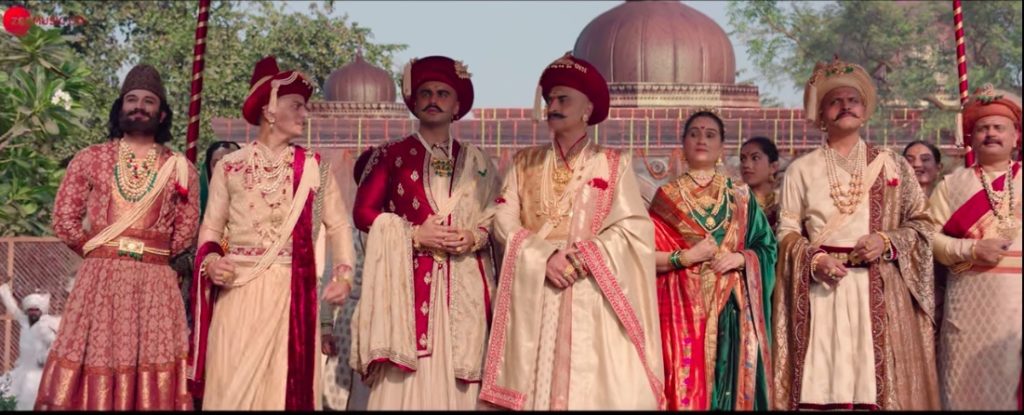
In creating these comparisons, the film uses the idea of family to drive home the point about good and evil. Marathas live in familial spaces (Fig. 2), express feelings of love, compassion and brotherhood for each other, while Abdali brutally murders his brother. Afghan camps (Figs. 3 and 4) are cold, dark and fearsome male spaces. In contrast, in the Maratha camp, women lovingly prepare daily feasts for the soldiers. The Marathas defend brotherhood, love, conjugality, and family against a brutal and homosocial world of Afghans, which is bereft of both female presence and all positive human emotion. It is only in a victory which is tinted with an enormous military loss that Abdali is shown to feel anguish, as he acknowledges the moral victory of the slain Sadhashiv Rao and other Maratha warriors in a letter written to the Peshwa. While we get to see the Marathas mourning their dead, in yet another example of the dehumanization of the Afghan warriors, we do not get to see the mourning of the Afghans, who suffer losses too.
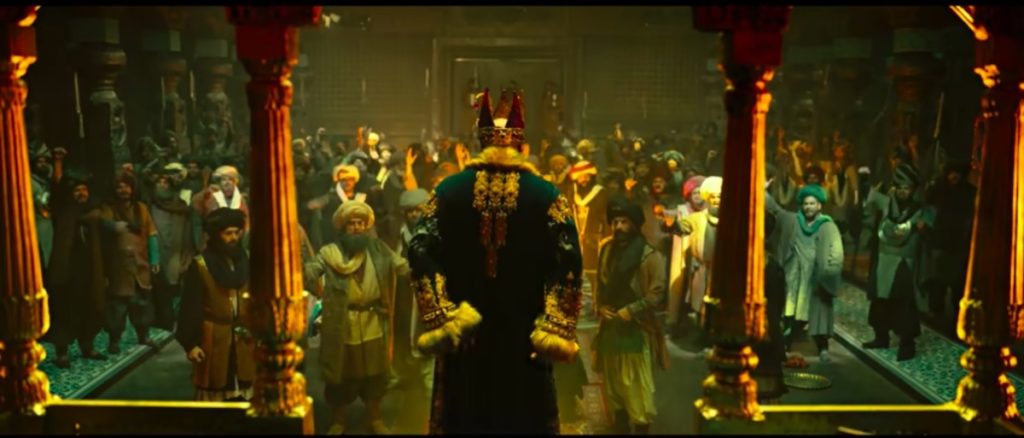
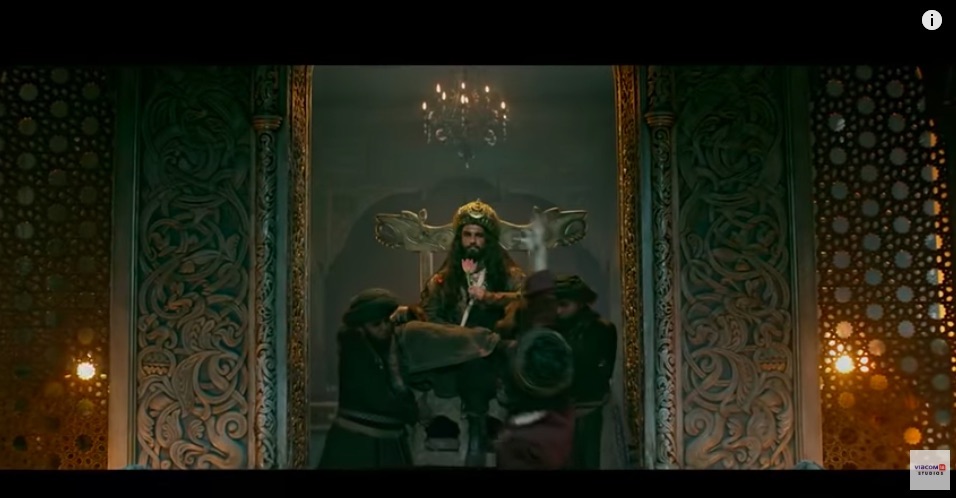
The film’s female protagonist Parvatibai, Sadashiv Rao’s wife (played by Kriti Sanon) is a refreshing change in the manner of portraying women in the recent historicals. She is shown to be a trained physician, and accompanies her husband to Panipat. When the Marathas run out of supplies she convinces Sakina Begum to help the Maratha army. She even picks up a sword to fight Afghan soldiers when they attack the women’s camp. She does not commit sati, but escapes to Poona, where she dies heartbroken.
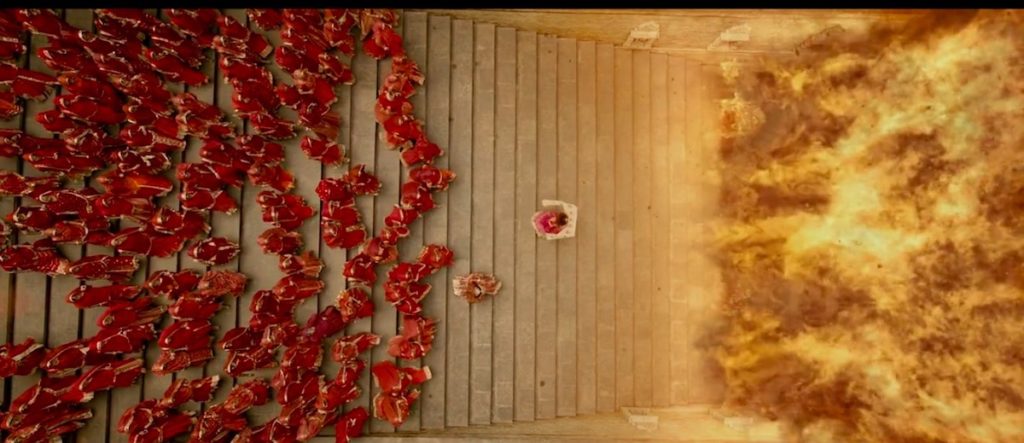
A trope that has dominated recent historicals entails protecting the female body against the marauder, often a Muslim. In the event the female body cannot be protected (owing to the death of the husband, the protector) it has to be destroyed through the act of jauhar (Fig. 5) or sati.[13] In Bajirao Mastani, women of the Bundela king Chhatrasal ’s household are shown preparing for jauhar as the fort is besieged by the Muslim invader. In Padmaavat, Padmini commits jauhar along with other women in the climactic moments. It has been argued that Padmini’s decision to commit jauhar as the men leave for the climactic battle is an empowering choice.
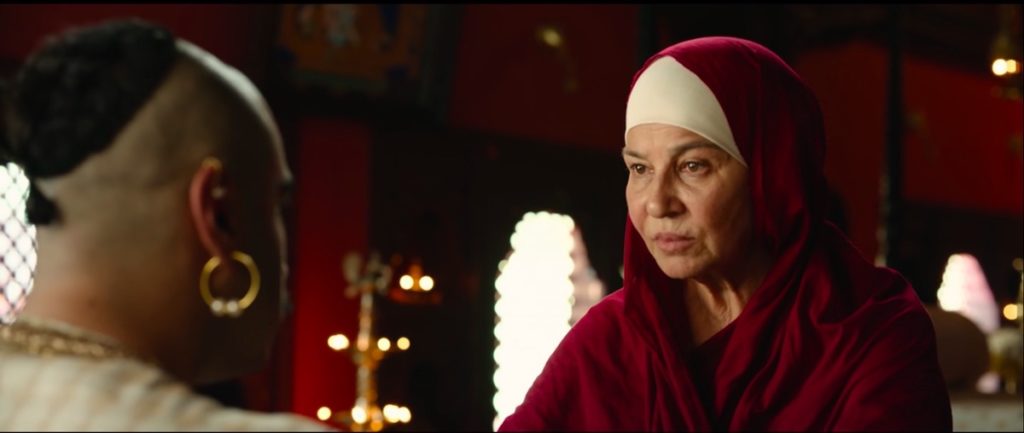
Films on Maratha history, however, mark a shift in the destiny accorded to female characters (Fig. 6). These women are unveiled, live beyond their husband’s deaths, and sometimes act as advisors to their sons, like Radhabai, the mother of Peshwa Bajirao in Bajirao-Mastani. These characterizations are drawn from real women in Maratha history, where women like Tarabai (1675-1761), Ahilyabai Holkar (1725-1795), and Laksmibai (1828-1858), all widows, participated in the real-politic of their time. Shivaji’s mother Jijabai (1598-1674), a woman estranged from her husband, is believed to have had a tremendous influence on her son. Kashibai, the widow of Peshwa Bajirao, brought up her half-Muslim stepson Shamsher Bahadur as her own against the dominant Brahmin opinion. Rajput women portrayed in historical films like Jodha Akbar (and Padmaavat) exist within the historical record behind veils of anonymity, unnamed as they were addressed by their fathers’ names.[14] Portrayal of women in films about Maratha history is noteworthy as these do not show the Hindu female body as the cause and center of conflict—bodies to be owned, veiled and safeguarded from the lustful Muslim enemy, and to be destroyed by fire when they cannot be protected.
Ashutosh Gowrikar’s Jodha-Akbar (2013), which narrates the gradual transformation of the Mughal emperor Akbar from a zealous warrior to a benevolent ruler under the influence of his fictional Hindu Rajput wife Jodha, set the standard for grandeur in the later historicals with the narrative unfolding in lofty and intricately beautiful palaces. Jodha-Akbar, shot in the Amer Fort, and Padmaavat, shot in the Chittaur Fort, create the ambience of grandeur associated with Mughals and Rajputs.
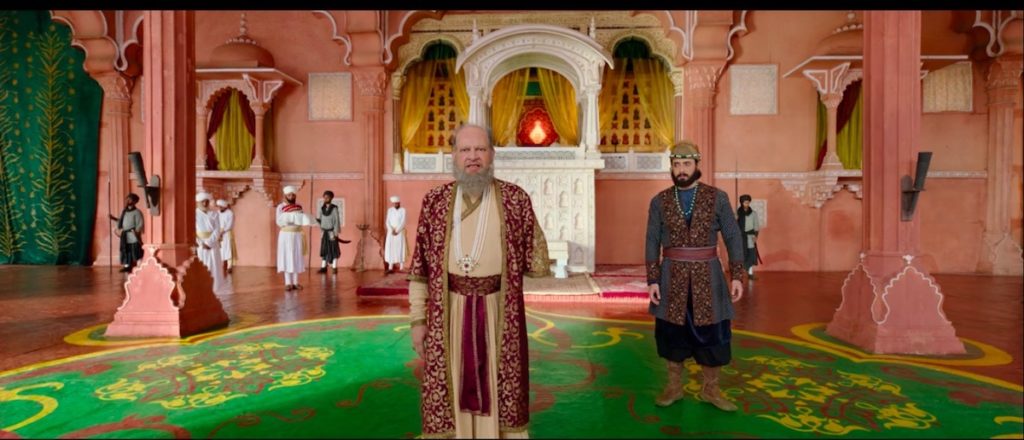
Panipat falls short of meeting the expectations regarding grandeur set by Jodha Akbar at several levels, thus sometimes failing to convey the historical sensibilities of eighteenth-century India. Shot on film sets, Panipat disappoints the viewer with forts and palaces that appear to be patched together. The eighteenth-century Peshwa court in Shaniwarwada, as well as the later Maratha palaces in Baroda and Gwalior, attempted to replicate the magnificence of the Mughal palaces, both spatially and in courtly etiquette, something which does not quite come through in the sets of Panipat.[15] Most of these sets seem like wood and board structures put together like an amateur theatrical production. The Mughal throne room or Diwan-e-Khas (Fig. 7) in the Red Fort in Delhi looks like a small platform surrounded by floor design made of paint, rather than the grand room that the British pillaged in 1857 (Fig. 8).
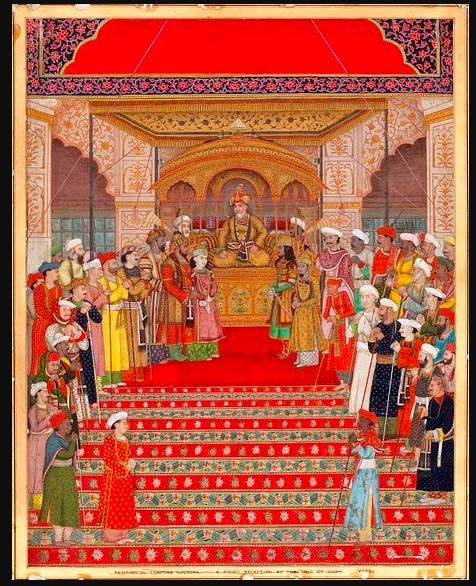
In fact, the set for Sadashiv Rao’s wedding in Panipat comes pretty close to any wedding hall in contemporary India, where many a wedding is themed on royalty. It is interesting, however, that the image of royalty and grandeur that both the movies and themed weddings propagate is itself a representation of how royalty has been imagined and popularized in visual cultures over the years, particularly in the areas of fashion and design. In recent years lavish destination weddings have become popular with status-conscious Indians, and have created their own cultural following that is often replicated in television and film.
Gowarikar’s actors also fail to bring home the grandeur and gravitas associated with historicals, a legacy of Indian cinema drawn from early-to-mid-20th-century film stars like Sohrab Modi, Prithviraj Kapoor, and Dilip Kumar. Arjun Kapoor as Sadashiv Rao is flat and devoid of all emotion and is a bad choice to play the role of Bhau. Sanjay Dutt’s hamming as Abdali recalls his iconic role as khalnayak (anti-hero) during the 1990s rather than bringing to life an Afghan warrior/king who, unlike the manic murderer shown in the film, was a shrewd campaigner and warrior. The rest of the cast just about manages their roles, and the whole film appears like an average television serial with expected cues and dialogues.
Cinema as a medium has the possibility of expanding beyond its given narrative. A film on the battle of Panipat that had historic consequences for the Indian subcontinent offered immense possibility for exploring complex interrelationships between various factions and personalities. Panipat unfortunately uses this possibility rather narrowly to suit a contemporary right-wing political agenda. The insistence on tracking the trajectory of proto-nationalism in India, and giving Marathas a role in that trajectory, leaves little space for considering contestations and alliances of identity among groups like Rajputs, Jats, Marathas, Sikhs and Mughals, as well as the pathos associated with battles. Instead what we have are flat binaries of good and bad, of those with us, and those against.
Panipat fits into the trajectory of social roles played by cinema in society explored earlier in this article. At this juncture in India, where nationalism has emerged as a prime question, and where proving one’s fidelity to a right-wing idea of nationalism has become a daily test, Panipat relocates these questions to events of the past. The historicals of the 1940s and 50s focused on ideals of justice and ethics in the project of nation making. For the historicals of the 21st century, it is the fictional claim to original citizenship that is the primary question, one that Panipat drives home.
Tanuja
Kothiyal is Professor in the School of Liberal
Studies and teaches History at Ambedkar University Delhi
[1] T S Shejwalkar, Panipat: 1761 (Pune: Oriental Watchman Publishing Company and Deccan College Post-Graduate Institute, 1946).
[2] Tanul Thakur, “Propaganda Weighs Down an Already Mediocre Film,” The Wire (January 11, 2020), https://thewire.in/film/tanhaji-movie-review (accessed January 28, 2020).
[3] Marathas as well as Afghans were often invited to settle inter or intra kingdom disputes among rulers in northern India. In return Marathas would claim tribute in form of taxes like Chauth (one-fourth of the revenue) and Sardeshmukhi (a due from headmen/chiefs, usually 10 to 12 percent of revenue), apart from huge war indemnities. Maratha armies also included irregular Afghan soldiers or Pindarries, who provided mercenary support to a number of north Indian kings. Tanuja Kothiyal, Nomadic Narratives: A History of Mobility and Identity in the Great Indian Desert (New Delhi: Cambridge University Press, 2016), 112-113.
[4] J N Sarkar, Fall of the Mughal Empire (New Delhi: Orient Longman, 1999), vols. II and III.
[5] Shivaji’s coronation included his being anointed as a Kshatriya by a Brahmin from Kashi. It also involved ‘locating’ a genealogy that linked Shivaji with a Sisodiya Rajput line from Mewar, thus making him a Rajput of the solar line. J N Sarkar, Shivaji and his Times (London: Longman Greens, 1920), 158-159; Stewart Gordon, Marathas: 1600-1818 (New York: Cambridge University Press, 1993), 87-88; and James Laine, Shivaji: Hindu King in Islamic India (New York: Oxford University Press, 2003), 30-31.
[6] Panipat refers to pilgrims who came along with the army to visit holy sites in northern India. Gordon traces the rise of several important Maratha warrior clans in Marathas: 1600-1818. In addition to Gordon, scholars like Rosalind O’Hanlon also point out that by the end of the eighteenth century, Marathas had become the biggest patrons of religious sites like Banaras. Rosalind O’Hanlon, “Letters Home:Banaras Pandits and the Maratha Regions in Early Modern India,” Modern Asian Studies 44: 2 (2010), 201–240.
[7] D H A Kolff’s much acclaimed work Naukar, Rajput and Sepoy: The Ethnohistory of the Military Labour Market of Hindustan, 1450-1850 (Cambridge: Cambridge University Press, 1990), traces the consolidation of varied peasant and pastoralist warrior groups into the endogamous caste category of Rajputs around the fifteenth century. Rajput sources explaining this transition use the protection of Brahmins, women, and cows as a defining responsibility of the upper-caste Rajput. The claim made by Tanhaji’s wife Savitribai is indicative of a similar process of staking claim to Rajputhood among the Marathas.
[8] Shivaji appointed an eight-member council of ministers called the astapradhan, headed by a Brahmin Peshwa. While over time other positions became obsolete, the Peshwas became hereditary rulers of Poona, leading and controlling the evolving Maratha confederacy. Andre Wink, Land and Sovereignty in India: Agrarian Society and Politics in Eighteenth-Century Maratha Swarajya (Cambridge: Cambridge University Press, 1986), 37.
[9] Prathama Bannerjee, “Bhima Koregaon incident is a symbol of the long history of Dalit warriorship social mobility,” The Indian Express (January 23, 2020), https://indianexpress.com/article/opinion/columns/a-genealogy-of-valour-koregaon-bhima-dalit-warriorship-6220280/ (accessed January 28, 2020).
[10] In 2018, during the celebrations at Bhima Koregaon, violence was unleashed upon the Dalit celebrants, an event that has marred Indian public memory. Several civil rights activists accused of inciting violence were incarcerated.
[11] Maharashtra, the state to which Bhimrao Ambedkar belonged, has witnessed strident Dalit activism for a very long time, in political as well as cultural spheres. It is interesting that while medieval Maratha heroes find space in Bollywood cinema, at the same time Marathi and Hindi films like Fandry (2013),Court (2015), and Sairat (2016) have highlighted issues of caste oppression in Marathi society.
[12] Rachel Dwyer, “Top Ten Muslim Characters in Bollywood,” Critical Muslim, Issue 5.2 Love and Death, https://www.criticalmuslim.io/top-ten-muslim-characters-in-bollywood/ (accessed January 28, 2020). See also Abid Zafar, “Portrayal of Muslims in Bollywood Movies,” Pakistan Journal of Islamic Research (October 2018), https://www.researchgate.net/publication/328580196_Portrayal_of_Muslims_in_the_Bollywood_Movies (accessed January 28, 2020).
[13]Jauhar is a reported practice among Rajput women who commit themselves to fire, when defeat is imminent, in order to save themselves from being raped by attackers. Sati refers to the act of a widow’s immolation on her deceased husband’s pyre. Both practices have been reported to be prevalent in medieval Rajasthan, with memorial shrines dedicated to the dead women. Interestingly in Hindi cinema, death by suicide has often been the fate of the raped woman.
[14] A chapter on the life of Tarabai, the daughter-in-law of Shivaji and the regent of the Maratha kingdom from 1700-1708, can be found in Richard Eaton, A Social History of the Deccan, 1300-1761: Eight Indian Lives (Cambridge: Cambridge University Press, 2005), 177-203. Ahilyabai Holkar was the widowed daughter-in-law of Malharrao Holkar. She ruled Malwa from 1767 till her death. Apart from being an able ruler, she is also credited with developing the city of Indore and being a patron of several religious sites, as well as that of the textile industry in her capital Maheshwar. A film called Devi Ahilyabai made about her life in 2002 did not receive much success at the box office. During the eighteenth and nineteenth centuries, we find several examples of very powerful female rulers from different parts of India, such as Begum Samru (1753-1836), the ruler of Sardhana; Kittur Chennamma (1778-1829); and the four Begums of Bhopal (1819-1901). The name of the princess of Amber married to Akbar remains unknown. In any case, after marriage, Rajput princesses were addressed by their clan names rather than their given names, like Kachchwahi Rani, Hadi Rani and Rathodji.
[15] Richard Eaton, India in the Persianate Age (New Delhi: Allen lane, 2019), 355.
Cite this note as: Tanuja Kothiyal, “Panipat: A Bollywood film review,” Journal18 (February 2020), https://www.journal18.org/4695.
License: CC BY-NC
Journal18 is published under a Creative Commons CC BY-NC International 4.0 license. Use of any content published in Journal18 must be for non-commercial purposes and appropriate credit must be given to the author of the content. Details for appropriate citation appear above.
